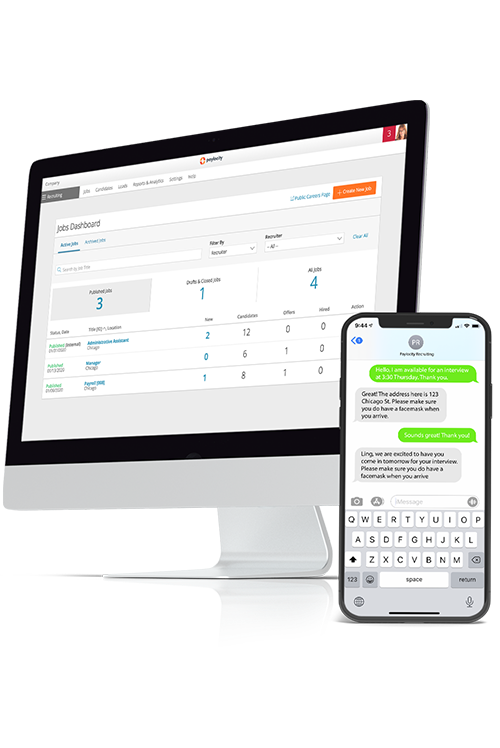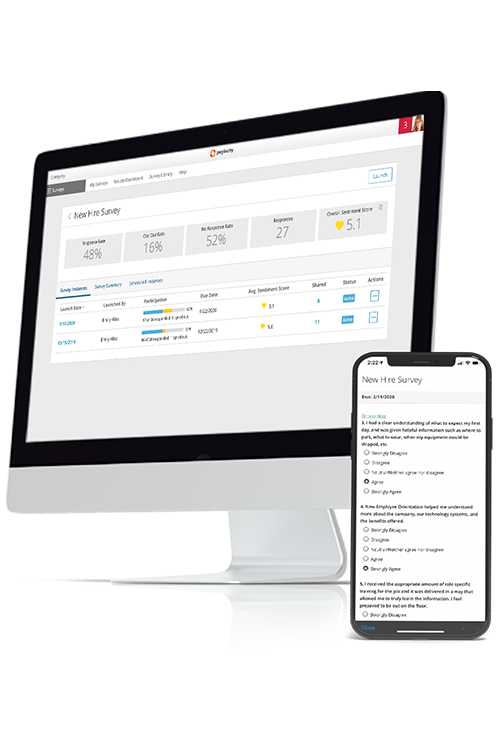Related Learning

ChatGPT Primer for HR
Explore how ChatGPT can transform HR practices with real-world applications and tips.
As artificial intelligence reshapes the HR landscape, it's time to embrace its transformative powers to enhance your daily operations. This practical guide is designed to demystify ChatGPT for HR professionals, but these actionable insights, real-world examples, and best practices also apply to other generative AI tools like Google’s Gemini, Microsoft’s CoPilot, and xAI’s Grok.
Whether you're drafting job descriptions, enhancing employee engagement, or navigating complex HR tasks, ChatGPT stands ready to revolutionize the way we work. Let’s explore how this powerful AI tool is setting the stage for a more efficient, inclusive, and forward-thinking HR environment.
Key Takeaways
- Payroll administration is a set of tasks, roles, and components that focus on maintaining or improving the legal compliance and logistics of an organization’s payroll system.
- Payroll administrators can have different duties depending on the size and nature of their employer, most of which go beyond completing the payroll process each pay period.
- Employers can also choose to manage payroll administration internally with a team of payroll administrators or externally by working with a payroll service provider or professional employer organization (PEO).
What is ChatGPT?
ChatGPT is an advanced AI language model and a type of generative AI, which means it can create human-like text based on the input it receives. For HR professionals, it’s a game-changer, offering capabilities like automating responses to employee queries, generating recruitment content, and providing insights from large sets of HR data. It helps streamline communications, improve efficiency, and support a more personalized employee experience.

How HR Can Use ChatGPT
AI streamlines HR processes and enhancing decision-making by automating repetitive tasks, providing valuable insights from data, and personalizing employee experiences. With it, HR teams can focus more on strategic initiatives that drive growth and employee satisfaction.
Because ChatGPT is a generative AI tool, HR can use it for the following and more:
- Crafting job descriptions
- Composing and updating employee handbook materials and policy manuals
- Drafting e-mails to job candidates, including offer letters
- Summarizing research and reports
- Generating employee surveys and sentiment analyses
- Streamlining administrative tasks, such as reminders about events and holidays
- Developing personalized career development plans
- Preparing performance reviews
- Scanning and screening resumes
- Compiling interview questions
Will ChatGPT Replace HR?
ChatGPT won't replace HR professionals. Like other generative AI tools, ChatGPT simply helps you work smarter, not harder, to drive innovation and growth.
Learn More: AI in HR: From Efficiency to Employee Engagement
How to Craft a ChatGPT Prompt
Creating the perfect ChatGPT prompt is key to unlocking its full potential. By providing clear, specific instructions, you can ensure the AI delivers the most relevant and useful responses.
- Context: Background on the Request
- Describe the situation: Start by providing a brief background or context for your request. This helps ChatGPT understand the environment and purpose of the task. For example, "We are looking to hire a new marketing manager and need to create a job description."
- Include relevant details: Mention any specific, important details for the task. For instance, "Our company focuses on digital marketing and values creativity and innovation."
- Task: What You’re Asking It to Do
- Define the task clearly: Specify what you want ChatGPT to accomplish. For example, "Write a detailed job description for a marketing manager."
- Be specific: The more specific you are, the better. Instead of a vague request like "Help with recruitment," say "Generate questions for a marketing manager interview."
- Define the task clearly: Specify what you want ChatGPT to accomplish. For example, "Write a detailed job description for a marketing manager."
- Instruction: How You Want It to Complete the Task
- Give clear instructions: Explain how you want ChatGPT to perform the task. For example, "Please include the job responsibilities, required qualifications,
- Set the tone and style: Indicate the tone or style if needed. For instance, "Use a professional and engaging tone that reflects our company culture."
- Clarity: Confirm It Understands the Request
- Check for understanding: Ask ChatGPT to confirm its understanding or summarize the request. For example, "Can you summarize the job description elements I’ve asked for?"
- Clarify any ambiguities: If ChatGPT’s summary shows it hasn’t fully understood, provide further clarification.
- Check for understanding: Ask ChatGPT to confirm its understanding or summarize the request. For example, "Can you summarize the job description elements I’ve asked for?"
- Revision: Revise Output if Needed
- Review the output: Carefully review the content generated by ChatGPT. Ensure it meets your requirements and aligns with your company’s standards.
- Provide feedback: If the output needs adjustments, provide specific feedback. For example, "Can you add more emphasis on leadership skills in the job description?"
- Refine and repeat: You might need to refine your prompt or provide additional details to get the desired result. Don’t hesitate to iterate until the output is perfect.
Example ChatGPT Prompts for HR Professionals
- "Create a job description for a senior software engineer with 5+ years of experience in AI and machine learning."
- "Generate a welcome email for new employees joining our marketing team."
- "Draft a policy on remote work for our company, including guidelines and best practices."
- "Provide a list of questions to ask during an exit interview for employees leaving the organization."
- "Write a response to an employee inquiry about the company's health benefits."
- "Develop a training module outline for new hires in the customer service department."
- "Generate a performance review template for mid-level managers."
- "Suggest ways to improve employee engagement in a remote work environment."
- "Create a script for an HR video explaining our diversity and inclusion initiatives."
- "Draft a survey to gather employee feedback on workplace satisfaction and areas for improvement."
Legal and DEIAB Considerations When Using ChatGPT
When using ChatGPT, remember there are important considerations — both legal and with respect to diversity, equity, inclusion, accessibility, and belonging — to ensure your practices are both compliant and responsible:
- Equal Employment Opportunity Commission (EEOC): ChatGPT can help streamline your hiring process and enhance diversity and inclusivity in your recruitment efforts, but don’t let it inadvertently introduce bias. Make sure the prompts you craft for job descriptions or interview questions comply with EEOC guidelines to promote fair and equal employment opportunities.
- General Data Protection Regulation (GDPR): If you’re handling personal data from individuals in the European Union (EU), GDPR compliance is a must. Ensure any data processed by ChatGPT is handled with care, protecting privacy and securing consent. Use ChatGPT to draft GDPR-compliant data handling policies and communication, fostering trust and transparency.
- AEDT (Automated Employment Decision Tools): With the rise of automated tools in hiring, AEDT regulations are becoming more prominent. Make sure any ChatGPT use in your HR processes is transparent, explainable, and non-discriminatory. Leverage ChatGPT to develop clear documentation and communication about how these tools are used in your organization.
- California Consumer Privacy Act (CCPA): Businesses dealing with California residents’ personal data must follow CCPA guidelines. ChatGPT use should respect each consumer’s rights to privacy and data protection. Use ChatGPT to generate CCPA-compliant privacy notices and responses to data access requests.
While AI can innovate and improve HR practices, it needs a little help from humans to uphold the highest standards of fairness, privacy, and compliance. Keeping these legal frameworks in mind allows you to harness the power of ChatGPT responsibly and ethically, ensuring our AI-driven tools benefit everyone.
Best Practices for Using ChatGPT
- Be clear and specific with prompts. When using ChatGPT, the clearer and more specific your prompts, the better the AI can deliver accurate and relevant responses. For example, instead of asking, "Help with onboarding," try, "Create a welcome email for new employees that outlines our onboarding process."
- Review and customize AI content. Always review the AI-generated content to ensure it aligns with your company's voice and culture. Customize it as needed to maintain a personal and authentic touch. This step ensures the content resonates well with your employees and stakeholders.
- Streamline routine tasks. Use ChatGPT to handle repetitive and time-consuming tasks such as drafting emails, creating job descriptions, and generating policy documents. This frees up your time to focus on more strategic and impactful HR initiatives.
- Maintain the human touch. While ChatGPT is a powerful tool, it should complement, not replace, human interactions. Use it to enhance communication and efficiency, but ensure that important conversations and sensitive matters are handled personally.
- Leverage data insights. ChatGPT can help analyze large sets of HR data, providing insights that inform decision-making and strategy. Use these insights to improve processes, enhance employee experiences, and drive organizational growth.
- Continuously improve prompts. Experiment with different ways of phrasing your prompts to see what yields the best results. The more you use ChatGPT, the better you'll understand how to craft prompts that get the most accurate and useful responses.
- Embrace innovation. Stay open to new ways of integrating ChatGPT into your HR processes. Whether it’s for training, employee engagement, or policy development, this tool can significantly boost efficiency and innovation within your team.
The Future of AI and HR
The future of AI in HR is incredibly promising, with innovations poised to transform every facet of the field. For example, we’ll see a surge in predictive analytics, allowing HR teams to anticipate workforce trends, optimize talent management, and make data-driven decisions.
AI will also augment employee experiences, creating more personalized and engaging interactions from onboarding to career development. However, ethical AI and bias mitigation will be at the forefront, ensuring fair and inclusive practices across the board. Additionally, AI-enabled employee wellness programs will become more prevalent, offering tailored support and resources to enhance overall well-being.
By embracing these advancements, HR professionals can lead with vision and empathy, shaping a more dynamic and supportive workplace.
Learn More: Two HR Technology Trends for 2024: From AI to EX
Leverage AI for Smarter HR
Incorporating AI into HR isn’t just a trend; it’s a transformative shift that promises to evolve how we work. From predictive analytics and personalized employee experiences to ethical AI practices and enhanced wellness programs, the future of HR is bright and full of potential.
That’s why Paylocity has incorporated generative AI in our all-in-one HR and payroll software to be the most modern solution on the market:
- Broadcast AI-generated announcements in our collaboration hub, Community.
- Compose clear and compelling job descriptions in Recruiting.
- Generate reviews and analyze employee sentiment in Performance Management.
Request a demo to see how your organization can leverage AI for smarter HR.




